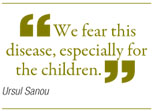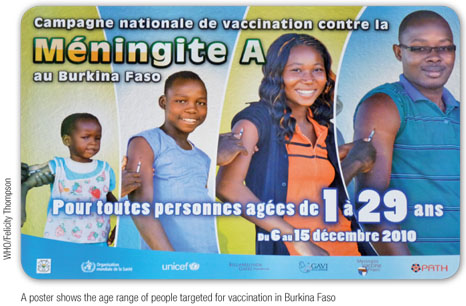NEWS
End of a century-long scourge?
As this year's meningitis season comes to a close, Felicity Thompson reports on how a new vaccine that costs less than a soda pop is making inroads into a dreaded disease in Africa.
Every morning before her children go to school, Ursul Sanou takes out a pot of shea butter and spreads gobs of the greasy substance around her children's nostrils. "I'm really afraid of meningitis," Sanou says. "I have terrible memories as a small child of my schoolmates falling ill and dying from meningitis."
Sanou lives in Zogona, a densely populated neighbourhood of Ouagadougou, the dusty capital of Burkina Faso in West Africa's infamous meningitis belt. Now a mother with five children of her own, Sanou takes no risks. "We fear this disease, especially for the children. We know how dangerous it is it leaves children damaged. For adults it's not so bad. But for the children [if they survive] it's much worse."
Meningitis, which attacks the lining of the brain and the spinal cord, kills half of those who do not get treatment. Up to one fifth (1020%) of meningitis survivors must live with disability ranging from loss of hearing and speech to mental retardation. Children and young people are particularly susceptible.
More than 450 million people live within the "meningitis belt" a band stretching across 25 African countries, from Senegal's sandy shores in the west to Ethiopia's jagged mountains in the east. For more than a century, these countries have had devastating outbreaks of the highly contagious disease. In 1996, the largest meningitis epidemic known to man infected 250 000 people and killed more than 25 000. In northern Nigeria alone it infected 75 000 people and killed more than 8000. The human loss was overwhelming and the resources needed to control it were massive.
"The impact that these epidemics have in sub-Saharan Africa is devastating," says Marie-Pierre Preziosi, of the World Health Organization's (WHO) vaccine research and development team, which has been collaborating with partners on the development and licensing of the new vaccine. "The loss of life and huge number of children left with life-long disabilities, not to mention the financial drain on public health resources that coping with these epidemics requires, is very hard to bear."

Meningitis has alarmed parents and paediatricians in Europe and North America for centuries but, fortunately for them, routine vaccine programmes mean that there are very few outbreaks in these parts of the world. Effective conjugate vaccines, protecting against the several strains of meningococcal meningitis, have been on the market for around a decade. But selling at around US$ 100 a shot, they have been beyond the means of most African countries.

Instead, meningitis-belt countries had to rely on a cheaper, older vaccine (US$ 1.60 a shot) with limited protection against the most prominent strain. Meningitis A, the deadliest strain of bacterial meningitis, is responsible for up to 85% of all cases in epidemics in the meningitis belt. "Meningitis A is the most dangerous," says Mamoudou Harouna Djingarey of the Meningitis Vaccine Project. "This is because it is capable of provoking the largest epidemics which spread rapidly across countries of the meningitis belt, much more easily than the other strains."
Transmitted through bacteria in nose and throat secretions, this deadly strain spreads quickly through prolonged close contact, such as kissing, sneezing or coughing, or living in close quarters with an infected person. This means those living in poverty or in high population density are at increased risk. Climatic conditions in the Sahel during the dry season also accelerate transmission, says Djingarey.
"A lot of dust, hot weather and low atmospheric humidity mean the dust particles irritate people's nasal passages," he says. "The heat dries up nasal mucus; the dust irritates and weakens the nasal pharynx. This facilitates the penetration of the germs into the blood."
So for those who live in the dusty inland countries on the southern edge of the Sahara, meningitis is an annual spectre, sweeping in with the harmattan winds in November and only dying down with the first drops of the rainy season in June.
Though epidemics arrive every few years, many meningitis belt countries have weak health surveillance systems, making outbreaks difficult to predict and rendering short-term vaccines, such as the older vaccine, ineffective. The fight against meningitis in this region has been characterized by reactive vaccination campaigns in the midst of emergency situations, where health workers find themselves constantly a few steps behind the epidemic.
Preziosi says that emergency vaccination campaigns are far less effective than preventive campaigns: "Emergency campaigns are a constant race against time. With adequate planning, preventive campaigns can reach close to 100% of target populations, and have a much greater impact on the number of people getting sick."
At last, for the price of a soda drink, Africans can receive a decade's immunity from this deadly strain of meningococcal meningitis, thanks to a new vaccine that was 10 years in the making. The new vaccine, known as MenAfriVac, costs around US$ 0.60 and that includes the vaccine, syringe and hazardous waste disposal. "This new vaccine is much more immunogenic [than the older ones] and we hope that it will provide protection for more than 10 years," says Djingarey.
"It should act against carriage of the bacteria and it can be used in children aged less than two years. The fact that it protects against carriage means it reduces human transmission, and so it enhances a population's herd immunity," Djingarey says, adding that the vaccine is revolutionary, because of the kind of partnership that made it happen, not because of the science behind it.
"Conjugate vaccines already existed," he says. "So the challenge was not the vaccine, but the price." African governments needed an effective conjugate vaccine at a price they could afford, and they needed it as soon as possible. The big pharmaceutical companies were not interested.
In 2001, the Meningitis Vaccine Project, a partnership between WHO and PATH (formerly the Program for Appropriate Technology in Health), a nongovernmental organization, was established. Its mission is to eliminate meningitis as a public health problem in sub-Saharan Africa. Thanks to a US$ 70 million grant from the Bill & Melinda Gates Foundation and a remarkable set of partnerships including close collaboration with vaccine manufacturer, the Serum Institute of India, a cheap, effective and long-lasting vaccine was developed especially for Africa's meningitis belt.
"It's a revolution in partnerships between the north and south and also between south and south," Djingarey says. "This is a great example of publicprivate partnerships that can be used as a model for other diseases."
In December 2010, massive campaigns were rolled out in Burkina Faso, Mali and Niger, to immunize populations aged between one and 29 years with the new vaccine. "We are already seeing results in all three countries. Since December, there have not been any cases of serogroup A meningitis in people vaccinated," Djingarey says.

Despite this remarkable progress, meningitis remains an urgent problem in the region. Just two years ago, a major epidemic swept through the zone infecting 85 000 and killing thousands. Since March of this year, the central African nation of Chad has been in the grip of a meningitis epidemic, further complicated by re-established polio transmission as well as simultaneous measles and cholera outbreaks.
Protection of all those living in the meningitis belt is of course largely dependent on finding enough money. The GAVI Alliance, a core supporter of the vaccine's introduction, recently released US$ 100 million to fund its rollout in Cameroon, Chad, and Nigeria. An estimated US$ 375 million was needed to protect target populations in other countries. Fortunately, donor pledges exceeded expectations at GAVI Alliance's pledging conference in June, so the purchase of vaccines and half the operational costs for vaccination campaigns across the belt are all but assured. This leaves countries to fund 50% of operational costs, which for some may not be an easy task. The cost savings that would otherwise be spent on diagnosis, treatment and repeat vaccination campaigns with the new vaccine should serve as an incentive.

But money alone will not be enough. Africa's poor infrastructure and human resource gap are major obstacles to getting tens of millions of people vaccinated. First of all, the vaccine needs refrigeration. Most at-risk countries have intermittent power supplies in major cities and none in rural areas, making it difficult to maintain a cold chain.
Most meningitis belt countries have youthful populations. Of Nigeria's 150 million people, 42.5% are aged less than 14 years (around 88 million people) and almost half of Chad's population is in this age group. If the vaccine is to achieve herd immunity the level of immunization needed to keep the disease at bay in at-risk populations, health workers must ensure 90% of people aged 1 to 29 years are vaccinated.
The sheer number of people to vaccinate is immense and requires sufficient numbers of qualified health staff. "Getting enough vaccination teams is challenging in Africa," Djingarey points out. "The MenAfriVac is an intramuscular injection so you need professional people, and you need many teams of these professionals."
Ursul Sanou in Ouagadougou says she is happy about the new vaccine. All her children were immunized with MenAfriVac during the December vaccination drive. But, she says, she remains vigilant. "I tell other mothers that this is not a disease to joke about," Sanou says. "Follow the news, and when there are vaccination drives, do not hesitate to bring your children."
Several hundred miles to the west, a young mother sits in a plastic chair in Dakar's Albert Royer children's hospital, watching her 14-month-old son, Pathé. Pathé has a drip taped to his small hand but is recovering well from a bout of meningitis. His mother, Aida Diop, knew the warning signs and brought Pathé to hospital as soon as she noticed stiffness in his neck. Diop says that if there were a vaccine that could protect her son from falling ill again with meningitis, she would be the first to line up for it. 
